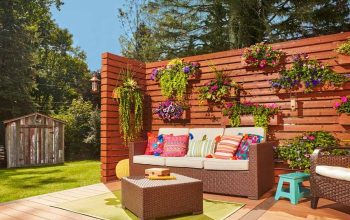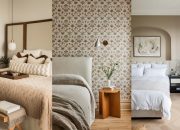Color Schemes and Wall Treatments

Modern living room decor ideas – Choosing the right color palette and wall treatments is crucial for setting the mood and style of a modern living room. The interplay of color and texture can transform a space, creating a calming oasis, a vibrant hub of activity, or a sophisticated sanctuary. Consider the overall lighting in your room and the desired ambiance when selecting your color scheme and wall finishes.
Modern Living Room Color Palettes
Three distinct color palettes, each offering a unique aesthetic and emotional response, are presented below. These palettes range from light and airy to deep and dramatic, showcasing the versatility of modern design.
Palette 1: Serene Neutrals
This palette uses a foundation of soft, muted neutrals to create a calming and sophisticated atmosphere. Imagine walls painted in a warm, creamy white, such as “Swiss Coffee” by Benjamin Moore, which provides a clean backdrop that enhances natural light. The upholstery could incorporate various shades of beige and gray, with subtle textural variations in fabrics like linen and boucle.
Accent pieces in pale wood tones, like light oak or ash, add warmth without disrupting the overall sense of serenity. This palette promotes relaxation and tranquility, ideal for a living room designed for unwinding and socializing in a peaceful setting. A textured linen wallpaper in a very pale, almost imperceptible pattern on an accent wall would subtly enhance the room’s refined character.
Palette 2: Vibrant Earth Tones
This palette embraces the richness and warmth of natural earth tones. Think deep terracotta walls, perhaps a shade like “Autumn Haze” by Sherwin-Williams, providing a grounding and inviting backdrop. This rich color is balanced by accents of warm beige and burnt orange in the furnishings. The use of natural materials, such as jute rugs and woven throws, adds a layer of texture and further connects the space to the natural world.
The overall effect is energizing yet grounding, perfect for a living room that balances both social gatherings and quiet moments. An accent wall featuring a subtle, geometric patterned wallpaper in muted greens and browns would further enhance the earthy feel.
Palette 3: Dramatic Darks
This palette utilizes a sophisticated blend of deep, saturated colors to create a dramatic and luxurious atmosphere. Imagine charcoal gray walls, perhaps a shade like “Iron Ore” by Sherwin-Williams, which instantly add depth and sophistication. This is offset by accents of deep teal or navy blue in the upholstery and accessories. Metallic accents, such as brass or copper, add a touch of glamour and warmth.
This palette is perfect for creating a modern living room that feels both stylish and intimate. A textured wallpaper with a subtle damask pattern in a dark metallic hue on one wall would amplify the sense of opulence. The overall feeling is one of refined elegance and sophisticated mystery.
Incorporating Natural Elements: Modern Living Room Decor Ideas

Introducing natural elements into a modern living room design isn’t merely a stylistic choice; it’s a pathway to creating a space that feels both aesthetically pleasing and profoundly calming. The inherent textures and colors found in nature offer a counterpoint to the often sleek and minimalist aesthetic of modern design, adding warmth, depth, and a sense of connection to the outside world.
This integration fosters a healthier and more relaxing atmosphere, enriching the overall living experience.The benefits of incorporating natural materials like wood, plants, and stone are multifaceted. These elements introduce organic forms and textures that soften hard lines and create visual interest. The natural color palettes, often featuring earthy tones and muted greens, promote a sense of tranquility and well-being.
Furthermore, many natural materials possess inherent qualities that improve air quality and contribute to a healthier indoor environment. Plants, for example, act as natural air purifiers, while wood can regulate humidity levels.
Natural Materials in Furniture, Flooring, and Accessories, Modern living room decor ideas
The versatility of natural materials allows for seamless integration throughout the living room. Wood, for instance, can be the star of the show in a statement piece of furniture, such as a live-edge coffee table showcasing the unique grain and character of the wood. Alternatively, it can be subtly incorporated into shelving units or a subtly textured wooden floor, adding a touch of warmth without overwhelming the space.
Stone, with its inherent coolness and durability, can be featured in a fireplace surround, adding a sophisticated and grounding element. Finally, plants, in varying sizes and types, bring life and vibrancy to the space. A large potted fiddle-leaf fig can act as a focal point, while smaller succulents can add pops of color and texture to shelves or side tables.
A Living Room Design Featuring Natural Elements
Imagine a living room bathed in soft, natural light. The floor is composed of wide, light oak planks, their grain subtly visible, creating a feeling of warmth and spaciousness. A large, low-slung sofa upholstered in a creamy linen sits against a wall adorned with a textured, light grey plaster finish. A live-edge coffee table made from reclaimed wood, its surface showcasing rich browns and hints of grey, anchors the seating area.
A stone fireplace surround, crafted from a light-grey, subtly veined stone, provides a dramatic yet elegant focal point. A large fiddle-leaf fig stands tall in a simple terracotta pot in one corner, its lush green leaves contrasting beautifully against the neutral tones of the room. Smaller succulents in various terracotta pots are scattered across the shelves, adding pops of color and texture.
The overall effect is one of serene sophistication, where the natural elements create a harmonious balance between modern minimalism and organic warmth. The textures – the smooth linen of the sofa, the rough grain of the wood, the cool smoothness of the stone – play against each other, creating a rich and inviting sensory experience. The color palette, predominantly neutral with pops of green, fosters a calming and peaceful atmosphere.
Modern Living Room Decor Trends

Modern living room design is a constantly evolving landscape, reflecting shifts in aesthetics, technology, and lifestyle. Three prominent trends currently shaping the modern living room are the embrace of biophilic design, the resurgence of maximalism, and the sophisticated use of monochromatic palettes. These trends, while distinct, often complement each other, offering a wealth of possibilities for creating a stylish and functional space.
Biophilic Design in Modern Living Rooms
Biophilic design, the intentional incorporation of nature into interior spaces, is experiencing a surge in popularity. This trend stems from a growing awareness of the positive psychological and physiological effects of connecting with the natural world. Its aesthetic appeal lies in the introduction of organic textures, natural light, and living elements that create a calming and refreshing atmosphere.
The practicality of biophilic design is evident in its ability to improve air quality, reduce stress, and enhance overall well-being. Imagine a living room bathed in sunlight, featuring a living wall of lush greenery, wooden furniture with natural grain patterns visible, and accents of natural stone. This creates a space that feels both sophisticated and inherently restorative. The use of natural materials like bamboo, rattan, and reclaimed wood adds warmth and texture, contrasting beautifully with sleek modern lines.
The Return of Maximalism in Modern Living Rooms
In contrast to the minimalist aesthetic that has dominated modern design for years, maximalism is making a bold comeback. This trend celebrates eclecticism, layering, and a vibrant use of color and pattern. Its appeal lies in its ability to express individuality and create a richly layered, visually stimulating space. While seemingly less practical than minimalism at first glance, maximalism can be surprisingly functional when thoughtfully executed.
Careful curation of items and a cohesive color palette can prevent the space from feeling cluttered. Consider a living room with a deep jewel-toned sofa, adorned with patterned throw pillows and a collection of unique artwork. A vintage rug layered over a neutral-toned carpet adds texture and depth. The addition of carefully chosen decorative objects, such as sculptures or antique vases, completes the look, resulting in a space that is both visually exciting and surprisingly organized.
The key is to create a sense of controlled chaos, where every element contributes to the overall aesthetic.
Monochromatic Palettes in Modern Living Rooms
The use of monochromatic palettes, featuring variations of a single color, offers a sophisticated and calming aesthetic. This trend’s appeal stems from its inherent elegance and its ability to create a sense of spaciousness and tranquility. The practicality lies in its simplicity; coordinating furniture and accessories is significantly easier when working within a limited color range. A living room designed around a monochromatic palette of deep blues, for example, could feature a navy blue sofa, lighter blue accent chairs, and various shades of blue in artwork and accessories.
The use of different textures – such as velvet, linen, and wool – within the same color family adds visual interest and depth, preventing the space from feeling flat or monotonous. This approach creates a sense of calm and sophistication, while also offering flexibility in incorporating other design elements, such as metallic accents or natural textures, to add subtle contrasts.
Clarifying Questions
What is the difference between minimalist and Scandinavian design?
Minimalist design prioritizes simplicity and functionality, often featuring a neutral color palette and minimal ornamentation. Scandinavian design, while also clean and simple, incorporates natural materials like wood and textiles, creating a warmer, more inviting atmosphere.
How can I make a small living room feel larger?
Use light colors on walls and floors to reflect light, choose furniture with clean lines and avoid bulky pieces, incorporate mirrors to create the illusion of more space, and maximize vertical space with shelving.
What are some affordable ways to incorporate natural elements?
Introduce potted plants, use wood accents like a coffee table or side table, incorporate natural fiber rugs or throws, or use stone coasters or decorative bowls.
How do I choose the right lighting for my living room?
Layer lighting using ambient (overall illumination), task (reading lamps), and accent (highlighting features) lighting. Consider dimmer switches for adjusting mood and brightness.










